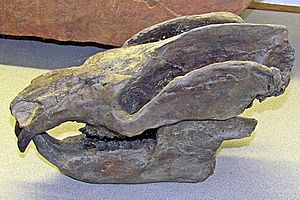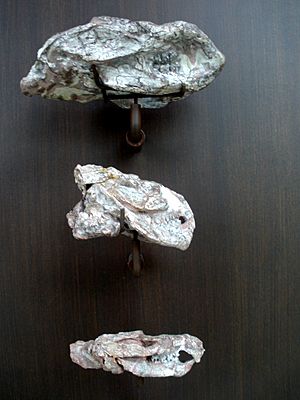Tritylodont facts for kids
Quick facts for kids TritylodontsTemporal range: Upper Triassic – mid Cretaceous
|
|
|---|---|
 |
|
| Oligokyphus | |
| Scientific classification | |
| Kingdom: | |
| Phylum: | |
| Class: | |
| Order: | |
| Suborder: | |
| Infraorder: |
Eucynodontia
|
| (unranked): |
Cynognathia
|
| Family: |
Tritylodontidae
Cope, 1884
|
Tritylodonts were ancient creatures that looked a bit like mammals. They were a type of cynodont, which are a group of animals related to mammals. These interesting animals ranged in size from a small rabbit to a larger beaver.
They were the very last family of non-mammalian synapsids. Synapsids are a group of animals that includes mammals and their close relatives. The name "Tritylodont" comes from their teeth, which had three special bumps, or "cusps."
Contents
What Did Tritylodonts Eat?
Tritylodonts were herbivores. This means they only ate plants. They chewed on things like plant stems, leaves, and roots.
They did not have canine teeth, which are the pointy teeth that many meat-eating animals have. Instead, they had incisors (front teeth) and special cheek teeth. Their jaws could move forward and backward. This helped them grind their food into small pieces.
How Long Did Tritylodonts Live?
Tritylodonts were the longest-surviving group of all the non-mammalian therapsids. They first appeared in the late Triassic period. They continued to live through the entire Jurassic period. They even survived until the middle of the Cretaceous period.
This long survival shows that tritylodonts were a very successful group of animals. They managed to thrive even though they lived at the same time as the huge dinosaurs.
Where Did Tritylodonts Live?
It is clear that tritylodonts were warm-blooded animals. This means their bodies could keep a steady temperature, much like mammals today.
Fossils of tritylodonts have been found in many places around the world. These include the Americas, South Africa, and Eurasia. It is possible they lived almost everywhere, even in Antarctica.
Tritylodonts and Other Mammal-like Animals
Tritylodonts were not mammals themselves, but they shared many similarities with a group of early mammals called multituberculates.
During the Jurassic period, tritylodonts did not have much competition for food. This is because other mammal-like animals at that time mostly ate meat or insects. However, when multituberculates appeared in the middle Jurassic, they also ate plants. This created direct competition between the two groups. Eventually, the multituberculates became more successful and replaced the tritylodonts.
See also
 In Spanish: Tritilodóntidos para niños
In Spanish: Tritilodóntidos para niños



